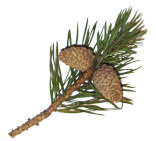[Last Update: January 2025]
The Arms
As is explained in "Scottish Clans..." King Malcolm III was the first person to bear arms in Scotland. He adopted the Lion Rampant (red on a gold ground) when he turned 21 (in 1052) while an exile at the court of Edward the Confessor. It should be emphasised that the Coat of Arms is the personal property of the Chief and should not be appropriated for use by anyone else.
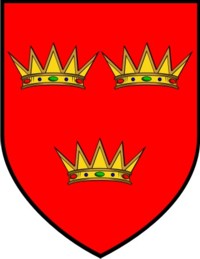
Arms of Grant
The arms of the Chief of Grant consists of three gold antique crowns on a red ground. These arms were adopted by Olaf Hemingsson in Scotland, probably on his 21st birthday in 1059. For some years the blazon was misrecorded in one armorial (in the 1500s) - and then copied into others - showing a blue rather than a red ground. Since 1719 this has had a 'label' at the top left as an "additament" signifying the baronetcy of Nova Scotia.
The Grant colours are the inverse of the Royal Arms - this was chosen deliberately to show vassalage.
The three crowns rather than one is an acknowledgement of status (ie below the king).
The emblem, the Ancient or Antique Crown, is not an imperial crown and has nothing to do with royalty (even though Olaf was descended from kings). The Ancient crown signifies Victory; it is a reference to and acknowledgement of the Angel Victorius who, as St Patrick tells us. appeared to him in his dream instructing him to go back to Ireland to evangelise the Irish (for why Olaf Hemingsson would hold St Patrick in such high regard see "Scottish Clans...").
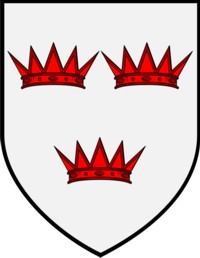
Arms ‘away’ variant
There is also an 'away strip' featuring three red crowns on a white ground (I interpret this as the original generic Viking colours). This was used when female Grants needed to be recognised in their husbands' arms. Thus Fraser of Lovat quarters this 'away strip' while in the case of the Lordship of the Garioch David Stewart superimposed the Grant red crowns onto his own Stewart coat.
Cadency in Arms was only formalised in the middle 1200s by Alexander II. So before this many junior Grants adopted other arms of their own choosing. Thus in England,
Thomas Grant chose "Argent, three Lions Lampant and a chief Azure" - the Lions Rampant reflecting his mother being a daughter of the Earl of Fife;
Richard chose "Ermine, three Mullets Or on a bend Azure" reflecting not only his clerical vocation but also his close association with the Mar and Bisset families, while William, in Ireland, chose the Grant arms with a blue ground and a white bordure.
Other Siol Alpin clans retained an Ancient Crown somewhere in their achievement of Arms signifying their descent from Olaf Hemingsson. These include the Moffats and the MacGregors.
For a very thorough collation of all known Grant Arms, there is no better nor more comprehensive a site than Stephen Plowman's pages at Heraldry-on-Line.
For a more general view of heraldry, the richest seam is the Scottish Heraldry Society's site.
The Plant Badge
Plant badges were of huge practical significance. In circumstances where there was no uniform as such, they served as an identifier - the way a soldier could tell friend from foe - and this remained substantially the case even up to and including Culloden (1746). [Nowadays we might think (mistakenly) of tartan. The first standard tartan happened to be established by a Grant in the early 1700s but they were slow to catch on. Their widespread use today was a brilliant marketing ploy on the part of weavers.]
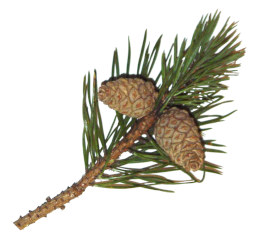
Scots Pine sprig
The plant used by the Grants is the Scots Pine tree.The fir tree had religious significance in pre-Christian Norway (the echo of this can be seen in the widespread use of Christmas trees today). But Olaf Hemingsson was a devout Catholic so this is unlikely to be the main reason for the choice. Much more likely it was an elegant pun because the Old Norse word for "fir tree" is "GRAN". It was used, at least originally, by all the Siol Alpin clans - who all descended from Olaf who had adopted "Grant" as a nickname. [The pine tree also figured on the original MacGregor coat of arms which showed a young tree pulled out of the ground by its roots - this a direct reference to an element of a legend about Jarl Haakon the Mighty (for which see the MS histories on this site). The Fir was later replaced by an oak tree.]
The Crest
The Crest is a
"Burning Hill"
This refers to the beacon on the top of Craigelachie, the prominent hill behind Aviemore, and to the era of Olaf Hemingson (1060-1098) who was given a large estate in Strathspey (stretching from Castle Grant and Angach downstream to Ruthven Castle and Kingussie upstream) at a time when Moray was still enemy territory so far as King Malcolm III was concerned. The Crest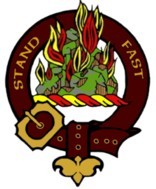
It should be noted that the MacKenzies share the same crest as the Grants. This is because the first Mackenzie took his name from Rothmackenzie (just north of Cornhill and due south of Portsoy on the Burn of Boyne). At the time when they adopted their name they were vassals of Richard Grant (died 1232) Chancellor of Lincoln and then Archbishop of Canterbury who had this estate in Scotland, probably courtesy of the Bissets. So the Mackenzies adopted Richard's crest. The reader should note that this crest was generic to the Grants over 100 years before they returned to Strathspey.
The War Cry

Craigelachie from the Doune at Rothiemurchus
The War Cry is "Craigelachie" (note the singular "l"). As with so many other clans the war cry indicated where the men were to muster when conflict was anticipated.
Meaning of Craigelachie: Far too many people continue to make the entirely vacuous and spurious claim that "Craigelachie" means "Rock of Alarm". Not so. In his "Placenames: Highlands and Islands of Scotland" (p249), Alexander MacBain says:
"The name reads in Gaelic as Eileachaidh, which appears to be an adjective formed from the stem ailech, a rock, nominative ail. The idea is the stony or craggy hill - a thoroughly descriptive adjective."
MacBain is right and wrong.
The problem is that the name has a Pictish origin. The "-ie" means burn. If we look at Timothy Pont's map of the area we find - as we should expect - a Loch Elachy and an Elachy burn.
Loch Elachy later became known as Loch Poladern. It is now, if it exists at all, a tiny part of its previous self. The new A9 runs right over what was the middle of it and the part below the road is entirely drained as part of the Hotel complex. The burn itself was culverted and diverted in order to provide water for steam trains stopping at Aviemore; any residual flow was piped into the Butcher's Burn. However the original course of the burn is echoed by the the underpass beneath the railway immediately south of the station.
And so we are left with the "eilach" part of the name.....
According to Dwelly, "eileach", has one of two meanings, either of which could be applicable
(a) "a weir or bank of stones where fish are guided into a cabhuil"
or
(b) "a place where water (in this case the Spey) can be crossed on stones (ie dryshod)".
However we noted above that the "-ie" indicated a Pictish origin; if we look in the Welsh dictionary we find that "elech" means "paving stone" - ie a flat stone for walking on - precisely the sort of stone which would have been needed for a safe dry-shod crossing of the Spey.
Given that these names are on the west bank of the Spey and that it is also the case that a road still runs past the Dell at Rothiemurchus to the exact point where the river would have been crossed, we can be confident that "Craigelachie" means "the crag by the burn which empties into the Spey where you can cross the river dryshod" and that like so many other supposedly Gaelic words the current Gaelic meaning and slightly Gaelicised form have been "borrowed" (ie stolen/absorbed) from Pictish.
Problems for the “Norman Tendency”: This is one of many places where those who want to promote a Norman-English origin fable for the Clan come completely unstuck. Olaf Hemingsson's connection to Strathspey ended with his execution in 1098. Recent research into the Robertsons and Skenes suggests that his son Malpeder may have hung on for a few years, but in any event there was no (proto-)Grant connection after 1130 at the very latest.

Tom Nan Carrach
When the Grants did return to Strathspey in 1316 it was to Inverallan and what is now Castle Grant. They did not acquire Glenchernick (now Duthil parish) until 1410 and thereafter their muster station was Tom nan Carrach. So there is no point in creating a War Cry "Craigelachie" when it should be "Tom nan Carrach"!
[Likewise, according to them, there had been no beacon to light at the very latest since 1232 (the end of the MacWilliam rebellion) and the Grants had no control of the hill until 1410 at the earliest.] So it is clear that the War Cry must have been adopted before 1098 and retained as traditional thereafter.
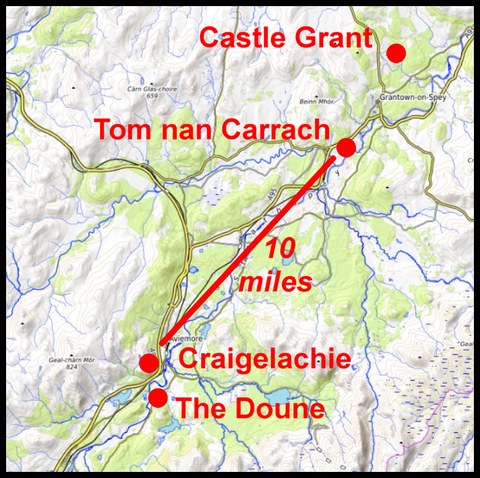
Craigelachie was important because that was where the beacon was to be lit; for that reason it was, in a sense, a "rock of alarm"; but that is not what the name means. The reason to muster there was due to its proximity to the Doune at Rothiemurchus which will have been Olaf's principal residence in the area in the period 1060-1097.
The Motto
The Grant Motto is "Stand Fast".
Even though he married a local girl, Olaf Hemingsson was a foreigner and so particularly expendible - so he was posted to the "front line". His clear instruction from King Malcolm III was to "Stand Fast" in the face of any attack from Moray.
The Supporters
The supporters either side of the shield are described as "Two savages wreathed about the head and middle with laurel each bearing on his experior shoulder a club Proper". This indicates that the Chiefs have depended on their clansmen for their wealth and their security.
Footnote
A certain "purism" seems to have overtaken heraldry in recent years. Most notably this has included the banning by Lord Lyon of any chief bearing a double-barrelled name. In the past several Grant chiefs have quartered their arms. Included amongst these have been James Grant, 7th of Freuchie (who quartered those of his wife Lady Mary Stewart) and, of course, the Ogilvie-Grant chiefs. However as with the name, in this respect also, the Grant Chiefs have reverted to first principles.
